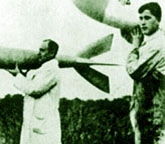Date: 5th July
2007 12:30 pm
Location: Workshop
Conditions: Cool and sunny.
Rockets:
(click the name for rocket details)
|
Name |
Capacity |
Notes |
|
Acceleron III |
24.75
L |
A new rocket expanding on
Acceleron II's capacity. It is also our first
two stage rocket booster. |
Team Members at
Event:
GK and PK
This was going to be a run of the mill
pressurisation test to mainly test the
staging and parachute deployment mechanisms.
It was to be the last full test before
launch. We set the booster on its launcher
and put a dummy sustainer on top. As we
began to fill and the pressure switch
started to activate, I turned on the flight
computer and armed it. Then we stood back
and continued filling it. We were filling it
quite slowly, so I put the video camera
down. Then as we were approaching maximum
operating pressure of 120psi, BOOM!
The failure was totally unexpected as the
booster had been tested previously to the
operating pressure. It was a very loud boom,
and my ears rang for a couple of minutes
afterward. You could hear it echo through
the neighbourhood. One of the neighbours came
out to see what had happened. Luckily the
other neighbour was away, otherwise we would
not have heard the end of it from them.
Since we didn't have footage of the
actual failure, and neither of us was
looking directly at the rocket at the time
we didn't know exactly what had happened. We
picked up as many of the pieces as we could
to try to reconstruct the rocket and see
where the failure occurred.
What Happened?
Although 6 bottles were pretty well
shredded and there was a whole lot of
pieces, we believe we know where the failure
happened. It looks like a bottle failed at
one of the holes of the base-to-base
coupling. The reason is because of the
damage done to both bottles at that point.
The two bases are completely shredded but it
looks like they flew apart at that point.
The lower bottle was turned inside out as
the coupling failed and the big hole acted
as a nozzle and forced the bottle down over
the other one. Also it is the only coupling
still missing. All others are still attached
to bottles or pieces of bottles.
The root cause is likely to be a hairline
fracture that developed at the hole of the
bottle and after numerous flights and
pressurisations it has propagated until
finally completely failing. We are now going
to modify our technique how we make the
holes for the couplings and heat treat the
edges with a soldering iron to reduce any
areas for stress fractures to develop. We
may also try another reinforcing technique
for the bottle bases other than the
strapping tape we have been using.
As the bottle ruptured, it caused a
cascading effect and the other highly
stressed bottles around it also exploded.
One of the bottles also shot upwards and hit
the pod. It looked like there was a lot of
damage to it, but when we later pulled it
apart, it turns out there was only minor
damage to a couple of lids, some of the
bulkheads, and the bottom cover. The staging
mechanism, flight computer, and servos
all survived well.
We also noticed that the nozzle from the
sustainer was missing. This we found
surprising, but later we found it and half
of the lid that was holding it. The nozzle
flange snapped and so the
nozzle can go in the bin. Something probably hit
the sustainer during the explosion and broke
the nozzle, which then shot out of the
staging mechanism.
The Tachyon sustainer was not fitted to
the booster during the test and hence
suffered no damage.
What's Next?
We rebuild of course! We have set a time
frame of two weeks to fully rebuild it.
Since last night most of the damage to the
pod has been repaired, and tonight it should
be fully operational again. We will have
quite a bit of lemonade to drink over the
next few days to replace the damaged
bottles.
We are going to pull apart the Polaron rocket as it already has 3 of the
bottles with couplings and use it on the
Acceleron IIIb rocket. We have a couple of
empty spare bottles as well so it should go
quite quickly.
We will keep more frequent updates on the
Blog of how the rebuild is going.
Lessons Learnt
- This was an example of what can happen
when working with water rockets. They can be
dangerous, and hence all possible safety
precautions should be taken. We had the kids
inside the house, and will continue do that
in future tests. I might inform the
neighbours too that if they hear loud booms
its probably only us.
- Bottles should be inspected after every
flight or test, and if excessive stress is visible,
they should be replaced.
- Always keep the video going during any
test. It can always be edited later.
|













